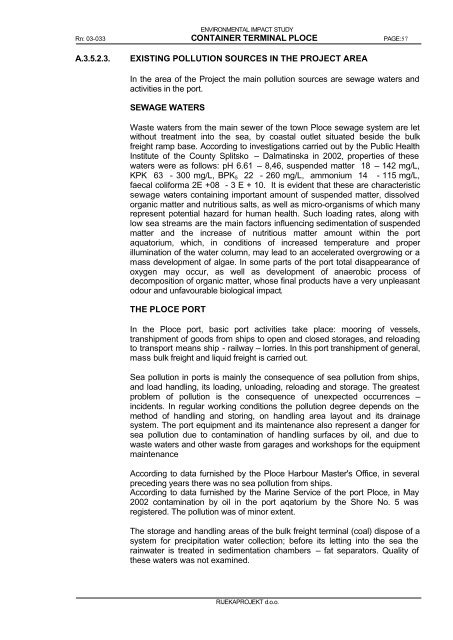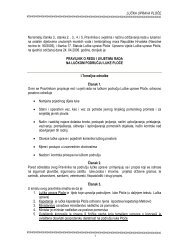HEADING PAGE - port of ploce authority * welcome
HEADING PAGE - port of ploce authority * welcome
HEADING PAGE - port of ploce authority * welcome
You also want an ePaper? Increase the reach of your titles
YUMPU automatically turns print PDFs into web optimized ePapers that Google loves.
ENVIRONMENTAL IMPACT STUDY<br />
Rn: 03-033 CONTAINER TERMINAL PLOCE <strong>PAGE</strong>:57<br />
A.3.5.2.3. EXISTING POLLUTION SOURCES IN THE PROJECT AREA<br />
In the area <strong>of</strong> the Project the main pollution sources are sewage waters and<br />
activities in the <strong>port</strong>.<br />
SEWAGE WATERS<br />
Waste waters from the main sewer <strong>of</strong> the town Ploce sewage system are let<br />
without treatment into the sea, by coastal outlet situated beside the bulk<br />
freight ramp base. According to investigations carried out by the Public Health<br />
Institute <strong>of</strong> the County Splitsko – Dalmatinska in 2002, properties <strong>of</strong> these<br />
waters were as follows: pH 6.61 – 8,46, suspended matter 18 – 142 mg/L,<br />
KPK 63 - 300 mg/L, BPK5 22 - 260 mg/L, ammonium 14 - 115 mg/L,<br />
faecal coliforma 2E +08 - 3 E + 10. It is evident that these are characteristic<br />
sewage waters containing im<strong>port</strong>ant amount <strong>of</strong> suspended matter, dissolved<br />
organic matter and nutritious salts, as well as micro-organisms <strong>of</strong> which many<br />
represent potential hazard for human health. Such loading rates, along with<br />
low sea streams are the main factors influencing sedimentation <strong>of</strong> suspended<br />
matter and the increase <strong>of</strong> nutritious matter amount within the <strong>port</strong><br />
aquatorium, which, in conditions <strong>of</strong> increased temperature and proper<br />
illumination <strong>of</strong> the water column, may lead to an accelerated overgrowing or a<br />
mass development <strong>of</strong> algae. In some parts <strong>of</strong> the <strong>port</strong> total disappearance <strong>of</strong><br />
oxygen may occur, as well as development <strong>of</strong> anaerobic process <strong>of</strong><br />
decomposition <strong>of</strong> organic matter, whose final products have a very unpleasant<br />
odour and unfavourable biological impact.<br />
THE PLOCE PORT<br />
In the Ploce <strong>port</strong>, basic <strong>port</strong> activities take place: mooring <strong>of</strong> vessels,<br />
transhipment <strong>of</strong> goods from ships to open and closed storages, and reloading<br />
to trans<strong>port</strong> means ship - railway – lorries. In this <strong>port</strong> transhipment <strong>of</strong> general,<br />
mass bulk freight and liquid freight is carried out.<br />
Sea pollution in <strong>port</strong>s is mainly the consequence <strong>of</strong> sea pollution from ships,<br />
and load handling, its loading, unloading, reloading and storage. The greatest<br />
problem <strong>of</strong> pollution is the consequence <strong>of</strong> unexpected occurrences –<br />
incidents. In regular working conditions the pollution degree depends on the<br />
method <strong>of</strong> handling and storing, on handling area layout and its drainage<br />
system. The <strong>port</strong> equipment and its maintenance also represent a danger for<br />
sea pollution due to contamination <strong>of</strong> handling surfaces by oil, and due to<br />
waste waters and other waste from garages and workshops for the equipment<br />
maintenance<br />
According to data furnished by the Ploce Harbour Master's Office, in several<br />
preceding years there was no sea pollution from ships.<br />
According to data furnished by the Marine Service <strong>of</strong> the <strong>port</strong> Ploce, in May<br />
2002 contamination by oil in the <strong>port</strong> aqatorium by the Shore No. 5 was<br />
registered. The pollution was <strong>of</strong> minor extent.<br />
The storage and handling areas <strong>of</strong> the bulk freight terminal (coal) dispose <strong>of</strong> a<br />
system for precipitation water collection; before its letting into the sea the<br />
rainwater is treated in sedimentation chambers – fat separators. Quality <strong>of</strong><br />
these waters was not examined.<br />
RIJEKAPROJEKT d.o.o.



